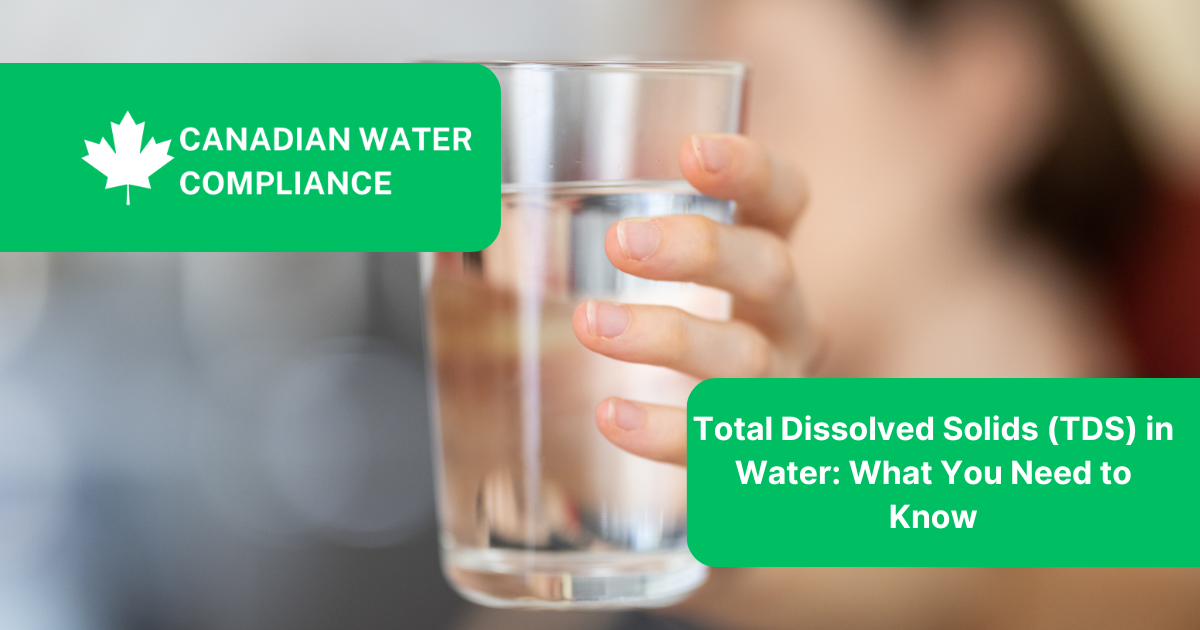
Written By: Canadian Water Compliance | On
Water isn’t just H₂O—it also contains various minerals, salts, metals, and organic matter. These substances contribute to a measurement known as Total Dissolved Solids (TDS), which refers to the combined content of all dissolved substances in water.
TDS levels impact water taste, health, and plumbing systems, making them an essential factor for both homeowners and businesses to monitor. But what exactly does TDS measure, and what does it mean for your drinking water?
In this guide, we’ll cover:
✅ What Total Dissolved Solids (TDS) are
✅ What causes high or low TDS levels in water
✅ Health implications of high TDS
✅ Ontario’s guidelines for TDS in drinking water
✅ How to measure and reduce TDS if needed
TDS represents the total concentration of dissolved substances in water, including:
Minerals: Calcium, magnesium, potassium, sodium
Salts: Chlorides, sulfates, bicarbonates
Metals: Iron, lead, arsenic
Organic compounds: Pesticides, herbicides, industrial runoff
TDS is measured in milligrams per liter (mg/L) or parts per million (ppm). The higher the TDS, the more dissolved substances are present in the water.
Several natural and human-related factors can lead to elevated TDS levels in drinking water:
🔹 Natural Mineral Deposits – Groundwater sources often have high TDS due to the natural dissolution of rocks and minerals.
🔹 Water Treatment Chemicals – Municipal water systems add disinfectants like chlorine and chloramine, which can contribute to TDS.
🔹 Agricultural Runoff – Fertilizers, pesticides, and animal waste can increase nitrate and sulfate levels.
🔹 Industrial & Road Salt Contamination – Factories, wastewater discharges, and road salts can introduce metals, salts, and pollutants into the water.
🔹 Aging Infrastructure – Old lead pipes or corroded plumbing can leach heavy metals into the water, increasing TDS.
While high TDS itself isn’t always dangerous, it can indicate potential water quality problems.
🚰 Effects on Taste & Odor
Water with high mineral content (calcium, magnesium, sulfates) may taste bitter or salty.
Excess sodium can make water taste “slippery” or “soapy.”
High iron levels may cause a metallic taste.
🏡 Plumbing & Appliance Damage
Hard water (high calcium & magnesium levels) causes scale buildup in pipes, water heaters, and appliances, reducing efficiency and lifespan.
High chloride levels can corrode metal pipes.
⚠️ Potential Health Risks
Nitrates & Arsenic: Excess levels of these contaminants can be harmful, especially for infants and pregnant women.
Heavy Metals (Lead, Copper, Mercury): These can enter water from old pipes and pose serious health risks over time.
Excess Sodium: Can be a concern for individuals on low-sodium diets.
In Ontario, the Safe Drinking Water Act provides water quality standards, but there is no enforceable limit for TDS. However, Health Canada recommends:
✔ Ideal TDS Levels: Below 500 mg/L (ppm) for taste and aesthetic reasons.
✔ Maximum Acceptable Level: Water above 1,000 mg/L may taste unpleasant and should be investigated.
While high TDS doesn’t always indicate contamination, it’s crucial to test your water for individual contaminants, especially heavy metals, nitrates, and industrial pollutants.
The easiest way to check TDS levels is by using a TDS meter, which provides a quick reading in ppm. However, a full laboratory water test is recommended to determine exactly what dissolved solids are present, especially if you rely on well water.
If your water has high TDS, treatment options include:
💧 Reverse Osmosis (RO) Systems – Removes up to 99% of dissolved solids, including salts, nitrates, and heavy metals.
💧 Distillation Units – Boils water and collects steam, leaving dissolved solids behind.
💧 Activated Carbon Filters – Helps reduce organic compounds, chlorine, and some chemicals but won’t remove minerals or salts.
💧 Water Softeners – Specifically target hard water minerals (calcium & magnesium) to prevent scaling in pipes.
Total Dissolved Solids (TDS) is an important indicator of water quality, but high TDS levels alone don’t always mean your water is unsafe. While minerals like calcium and magnesium are harmless, excessive heavy metals, nitrates, or industrial contaminants can pose health risks.
🔎 If you’re concerned about TDS in your drinking water, professional testing is the best way to ensure your water is safe.
📞 Need a professional water test? Contact Canadian Water Compliance today for expert testing and treatment solutions.